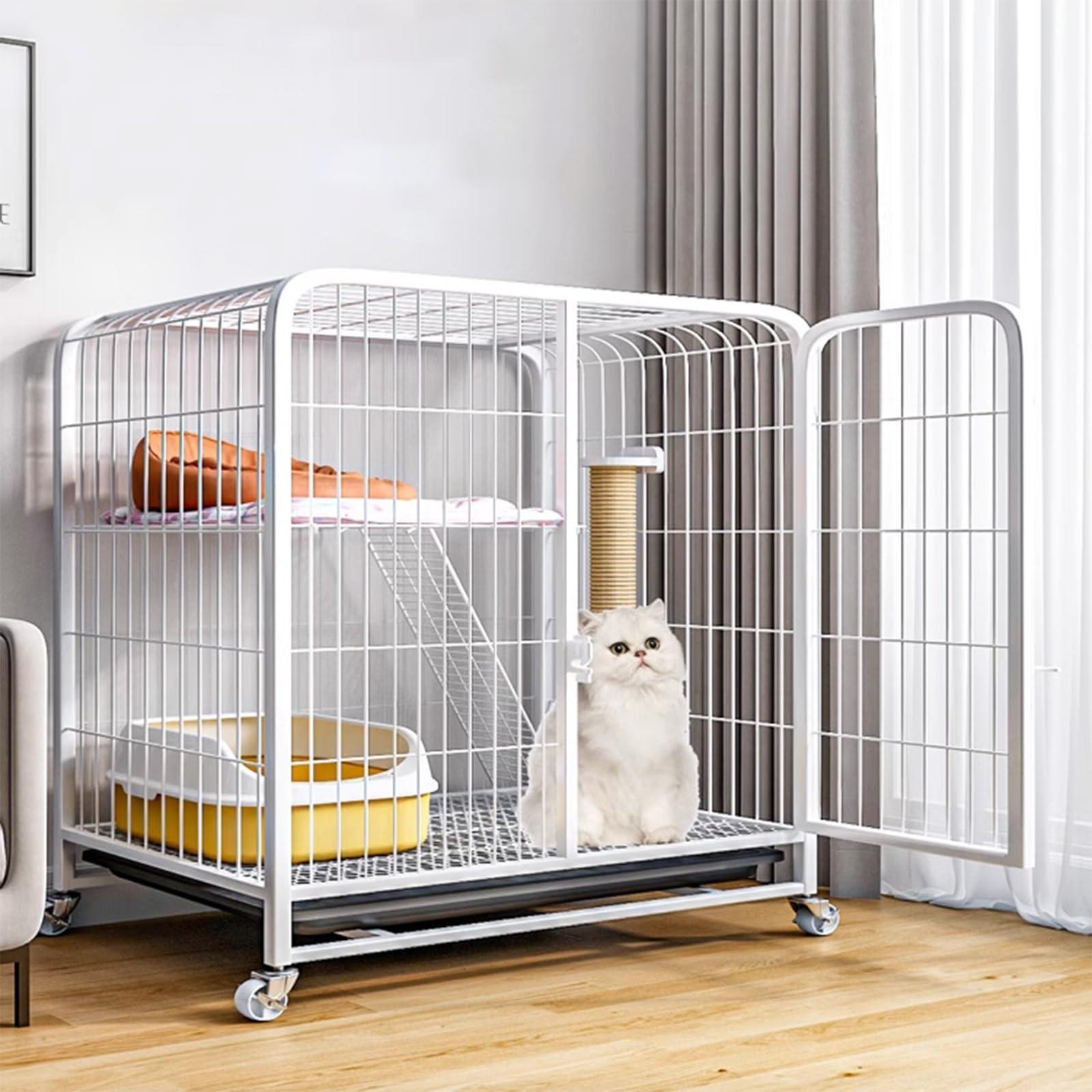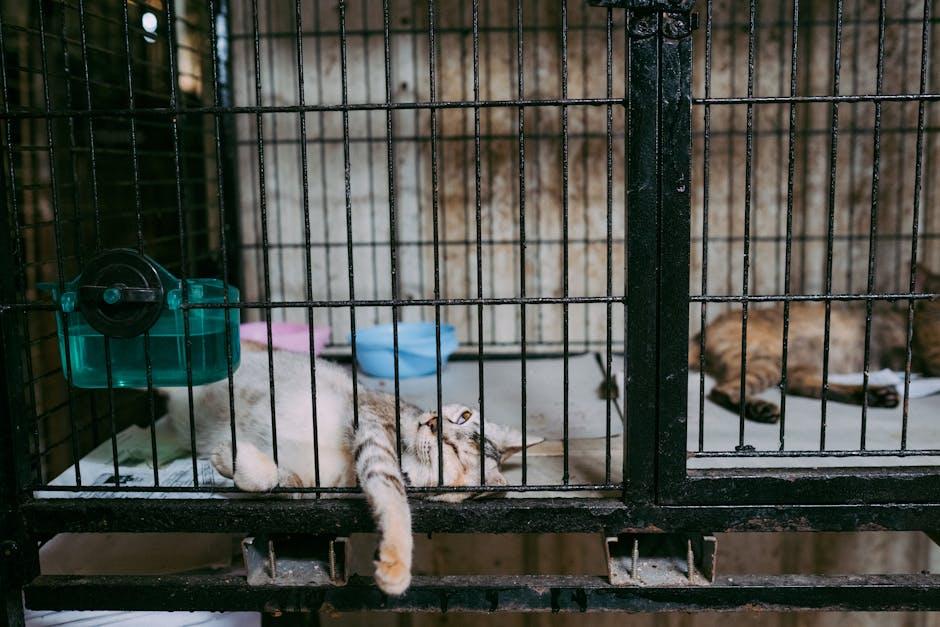In the world of pet ownership, the phrase ”My cat cage” conjures a diverse array of emotions and ideas. Whether you’re a seasoned cat owner or considering adding a feline friend to your household, understanding the role of a cat cage can be pivotal. Not merely a structure of confinement, a cat cage is a versatile tool for transportation, acclimatization, and safety. It offers a sanctuary for your cat amid a bustling environment, ensuring tranquility and security. As we delve into the intricacies of choosing and using a cat cage, this article aims to guide you through the essentials, helping you create a harmonious space where your cat can thrive. Join us as we explore how a well-chosen cage can enhance the life of your beloved feline, transforming it from a simple enclosure to an essential component of your pet care routine.
Table of Contents
- Choosing the Perfect Cat Cage for Your Feline Friend
- Creating a Comfortable Haven Inside Your Cat Cage
- Essential Features to Look for in a Cat Cage
- Expert Tips on Maintaining Your Cat Cage for Longevity
- Q&A
- In Retrospect
Choosing the Perfect Cat Cage for Your Feline Friend
When selecting the ideal enclosure for your whiskered companion, there are several key features to consider to ensure it becomes their safe haven. First and foremost, the size of the cage is paramount. The cage should allow your feline friend to stand, sit, and turn around comfortably. A general rule is to look for a cage that is approximately one and a half times the size of your cat, ensuring ample space to stretch and move without constraints[[3]].
Equally important is the durability and stability of the cage. Seek out models made from robust materials that can withstand a bit of feline curiosity and mischief. Metal and high-quality plastic materials are often recommended for their durability and ease of cleaning. Remember, a well-constructed cage will not only last longer but also foster a sense of security for your pet when they need to spend time inside.
For ease of transport and placement, consider cages with adjustable or removable features. Carriers that can quickly be assembled or folded down are particularly useful for those with limited space or who travel frequently. Additionally, look for cages equipped with secure locking mechanisms to ensure your cat cannot make an unexpected escape. This is especially important if the cage is intended for travel.
- Comfortable interior: Choose a cage with a soft lining or add a cushioned bed to make your cat comfortable.
- Ventilation: Ensure the cage has adequate ventilation to keep your cat cool and calm.
- Accessibility: A cage with multiple access doors can make placement and retrieval of your pet more convenient.
Lastly, pay attention to the safety features of the cage. Belting systems, when applicable, are essential for securing the cage during car rides to prevent any jostling around that might frighten your feline friend[[1]]. By taking the time to choose a well-suited cage, you provide not just a physical space for your cat but a sanctuary that contributes to their overall well-being.

Creating a Comfortable Haven Inside Your Cat Cage
Your feline friend’s comfort is paramount when designing their personal retreat. Consider integrating natural elements such as lush greenery and textured branches to mimic the serene beauty of the outdoors, creating a seamless transition between their indoor sanctuary and the world beyond. The strategic placement of small, non-toxic plants can add an element of exploration and curiosity, making boredom a thing of the past. Use branches as both decoration and functional climbing areas, catering to cats’ innate desire to climb and explore.
Interior seating is another essential component. Cushioned perches provide a cozy lookout for your cat to observe their surroundings or bask in the sunlight. Consider plush fabrics that are both durable and inviting, allowing for superb nesting. You could also introduce soft, washable blankets to add layers of warmth – perfect for those chilly nights. By stacking different textures, you not only enhance comfort but stimulate your cat’s senses, inviting them to make the space their own.
- Incorporate climbing structures with multilevel perches.
- Introduce ambient lighting for a relaxed atmosphere.
- Add DIY hideaways for privacy and play.
To elevate the aesthetic appeal, consider small personalized touches that reflect your cat’s unique personality. Perhaps a chalkboard with cute doodles or their name brings a playful rhythm to the space. Incorporate small toys and rustic decorations subtly throughout to captivate and maintain their interest. Engaging your creativity in these elements can turn ordinary enclosures into personalized havens, offering an ongoing narrative of excitement and exploration.
| Element | Purpose |
|---|---|
| Cushioned Perches | Comfort and Observation |
| Plants and Branches | Natural Exploration |
| DIY Hideaways | Privacy and Play |

Essential Features to Look for in a Cat Cage
When choosing a cage for your feline companion, several critical attributes ensure their comfort and safety. Size and space top the list. A proper cat cage should provide ample room for your pet to stand, turn, and stretch. Cats love to explore their environment, so consider cages that include multiple levels or platforms to give them the opportunity to perch or nap freely.
Ventilation is another essential aspect. Adequate airflow keeps your cat from overheating and ensures a constant supply of fresh air, essential for health and well-being. Look for cages with mesh or barred walls that allow for visibility and ventilation while still being secure enough to prevent escapes.
- Sturdy construction materials to withstand wear and tear
- Secure locks to prevent accidental escapes
- Easy-to-clean surfaces for convenient maintenance
- Comfortable bedding to provide a cozy resting area
Accessibility for both you and your cat is vital. Cages with multiple doors or easy-access panels make feeding and cleaning less of a chore. Consider models with openings at the top, side, and front to provide options that suit your living environment and your cat’s behavior.
| Feature | Importance |
|---|---|
| Size | Spacious for movement |
| Ventilation | Ensures fresh air |
| Material | Durable and pet-safe |
| Access Points | Easy maintenance |
Investing in a high-quality cat cage that balances functionality with comfort will contribute significantly to your pet’s happiness. Prioritize features that align with your cat’s personality and your lifestyle to create the perfect safe haven for them. Choose wisely, as the right cage can turn into a cozy corner your cat will love.

Expert Tips on Maintaining Your Cat Cage for Longevity
Keeping a cat cage in top condition requires regular attention and thoughtful care. Begin by prioritizing cleanliness, as a clean environment fosters good health. Schedule regular cleaning sessions at least once a week. Remove and wash bedding, scrub the litter box, and wipe down cage surfaces with non-toxic, pet-safe cleaners. Maintaining a hygienic living space will not only keep your feline friend happy but also extend the lifespan of your cage.
Ventilation is crucial for both the health of your cat and the longevity of the cage. Ensure the cage is located in a well-ventilated area, away from drafts and direct sunlight, which can lead to rapid wear and tear. If your cat cage has wire mesh sides, periodically check for any weak spots or signs of rust, and repair them promptly to prevent further damage. This will help in maximizing airflow and minimizing odor buildup.
Implementing a routine check can help you catch potential issues before they become major problems. Inspect hinges, locks, and any moving parts to ensure everything functions smoothly. Tighten loose screws and oil any squeaky parts to prevent them from deteriorating. Regular attention to these details not only promotes safety but also extends the usability of the cage.
Below is a handy maintenance checklist you can follow to ensure your cat cage remains in pristine condition:
- Weekly cleaning and sanitation
- Monthly inspection and repairs
- Bi-annual deep clean, including all nooks and crannies
Consider investing in quality accessories for your cage. Durable bedding, scratch-resistant panels, and sturdy feeding dishes not only enhance the comfort of your cat but also reduce the frequency of replacements. Choose accessories that are easy to clean and maintain, contributing to the overall longevity of your setup.
Q&A
Q&A: Understanding and Optimizing Your Cat’s Cage Environment
Q1: Why is my cat scratching and digging at the sides of her cage?
Cats may scratch and dig at their cage if they’re feeling stressed, bored, or attempting to release pent-up energy. It’s important to consider environmental factors, such as other pets in the vicinity or lack of stimulation within the cage. Ensuring that your cat has enough toys and comfort items can help ease these behaviors. Additionally, creating a peaceful environment outside the cage, like making sure your cat isn’t disturbed by other pets, such as a curious dog or chameleon, could also reduce stress and anxiety [[1]][[3]].
Q2: How can I make my cat’s cage a more comfortable place?
To make your cat’s cage more inviting, it should be equipped with soft bedding, toys, and scratching posts. Regularly rotating toys can keep the environment stimulating. Providing hiding spots and elevated platforms within the cage can also make it more appealing, allowing your cat to indulge in its natural desire for perching and privacy.
Q3: Is it okay to let my cat out of the cage at night?
Letting your cat out of the cage at night can be beneficial, provided that you’ve taken the necessary precautions. Bunnyproof rooms or spaces where your cat will roam, ensuring it’s safe from potential hazards and other pets, such as dogs or inquisitive reptiles like chameleons [[1]][[3]]. This freedom can help fulfil your cat’s natural instincts to explore and reduce cage-induced stress.
Q4: Are there special considerations if there are other pets around the cage?
Yes, if there are other pets, like a dog or lizard, making regular appearances near the cat’s cage, this might lead to anxiety or agitation in your cat. To address this, ensure that interactions between your cat and other animals are supervised and that the cage is placed in a location that minimizes direct visual contact with other pets who might unsettle your cat [[3]].
Q5: What if my cat won’t stop scratching the cage despite my efforts?
If the scratching persists, it may be a sign of underlying issues, such as insufficient stimuli or health-related concerns. Consider consulting your veterinarian for a thorough health check, and a pet behaviorist can provide additional strategies tailored to your cat’s needs. Additionally, enriching your cat’s environment both inside and outside the cage is crucial for their overall well-being.
This Q&A aims to help you create a more harmonious and comfortable living space for your cat, ensuring that both your pet’s mental and physical needs are met efficiently.
In Retrospect
In closing, the journey of finding the perfect cat cage is about more than just a secure enclosure; it’s about creating a comfortable haven for your feline friend. As every cat is unique, so too is the ideal space that caters to their need for safety and curiosity. Whether you envisage a simple design or an elaborate setup, the emphasis should always be on the well-being and happiness of your beloved pet. With thoughtful consideration and care, your cat cage can become an integral part of your pet’s life, offering them the comfort and security they deserve. Here’s to happier and more fulfilling days with your furry companion!







0 Comments